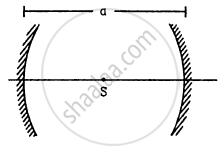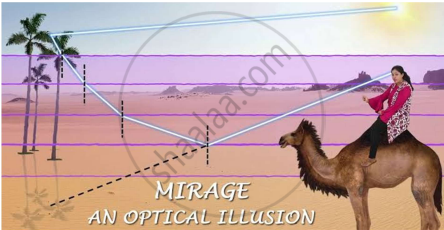Advertisements
Advertisements
Question
Why does unpolarised light from a source show a variation in intensity when viewed through a polaroid which is rotated?
Solution
A polaroid consists of long-chain molecules aligned in a particular direction. The electric vectors (associated with the propagating light wave) along the direction of the aligned molecules get absorbed. Thus, if an unpolarized light wave is an incident on such a Polaroid, the light wave will get linearly polarised with the electric vector oscillating along a direction known as the pass-axis of the polaroid, perpendicular to the aligned molecules. Therefore, if the light from an ordinary source passes through a polaroid sheet, its intensity is reduced by half. Rotating the Polaroid has no effect on the transmitted beam, and the transmitted intensity remains constant.
APPEARS IN
RELATED QUESTIONS
Give a scientific reason:
Danger signals are red in colour.
Draw the intensity distribution for the fringes produced in interference ?
Draw the intensity distribution for the diffraction bands produced due to single slit ?
The image formed by a concave mirror
A point object O is placed on the principal axis of a convex lens of focal length f = 20 cm at a distance of 40 cm to the left of it. The diameter of the lens is 10 cm. An eye is placed 60 cm to right of the lens and a distance h below the principal axis. The maximum value of h to see the image is
A candle flame 1.6 cm high is imaged in a ball bearing of diameter 0.4 cm. If the ball bearing is 20 cm away from the flame, find the location and the height of the image.
A point source S is placed midway between two converging mirrors having equal focal length f as shown in figure. Find the values of d for which only one image is formed.
Fill in the blank and rewrite the completed statement:
Very fine particles mainly scatter ______ light.
| Case study: Mirage in deserts |
 |
|
To a distant observer, the light appears to be coming from somewhere below the ground. The observer naturally assumes that light is being reflected from the ground, say, by a pool of water near the tall object. Such inverted images of distant tall objects cause an optical illusion to the observer. This phenomenon is called mirage. This type of mirage is especially common in hot deserts. Based on the above facts, answer the following question : |
A diver at a depth 12 m inside water `(a_(µω) = 4/3)` sees the sky in a cone of semi-vertical angle
| Case study: Mirage in deserts |
 |
|
To a distant observer, the light appears to be coming from somewhere below the ground. The observer naturally assumes that light is being reflected from the ground, say, by a pool of water near the tall object. Such inverted images of distant tall objects cause an optical illusion to the observer. This phenomenon is called mirage. This type of mirage is especially common in hot deserts. Based on the above facts, answer the following question : |
In an optical fibre, if n1 and n2 are the refractive indices of the core and cladding, then which among the following, would be a correct equation?
